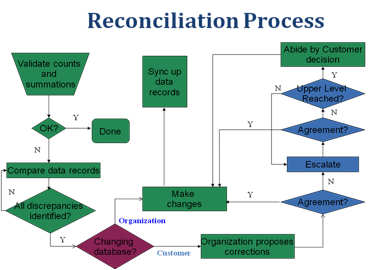SOTS
Overview Why Use SOTS SOTS Process Implementation SOTS Data File Record Acceptance Reconciliation Administrative Report (Optional) FAQsSOTS Documents
Header Records XLS Header Records XML Data Record XLS Data Record XMLAdditional Resources
SOTS Overview (PDF) SOTS - A Best Practice (PDF) Implementation Design Document (PDF) Outage ClassificationsReconciliation Process
The Reconciliation process focuses on the outage data to verify that outages are accurately described and to reconcile any differences between the customer and supplier view of the outage data. The reconciliation process can be performed continually as part of the record acceptance process or on a periodic basis (for example, monthly), reviewing and reconciling all outages that occurred during the period.
The record reconciliation process should be performed as soon as possible after the record is received by the Organization. Disagreements regarding the details of an outage should be resolved as quickly as possible while events are fresh in memory.
Resolving Disagreements
If the disagreement is on a point that neither TL 9000 nor the QuEST Forum addresses, then the Customer and Supplier shall negotiate the disposition of the disagreement.
If the disagreement cannot be settled at the working level between the Customer and Supplier, then the disagreement may be escalated to the next level of management. The highest level of escalation shall be the third level of management, which is sometimes known as the Director level or Senior management level.
IIf the disagreement is on a point that neither TL 9000 nor the QuEST Forum addresses, then the Customer and Organization shall negotiate the disposition of the disagreement.
If agreement cannot be reached at the Director level, then the customer decision shall be used.
The changes introduced by the disagreement resolution process SHOULD BE MADE ONLY IN THE CUSTOMER DATABASE and then the changed record retransmitted to the supplier for processing.
Time Limits
The Reconciliation process is intended to align the Customer and Organization outage data records, and reconciliation should be performed as soon as possible to the reporting period. In order to support the seven week timeline for TL 9000 data submission to the measurement repository, it is expected that the Reconciliation process will be completed within six weeks from the end of the reporting period. The Reconciliation process should only deal with data from reporting periods that have not yet been submitted.
It is important not to confuse the Reconciliation process with the Resubmittal process. Resubmittal or data correction is mentioned in the TL 9000 Measurements Handbook, and it states that the Organization must "resubmit corrected data for any erroneous data submitted within the previous two years". The Resubmittal process addresses the entire data submission and is not restricted to outage data, which is the primary focus of the the Reconciliation process. If a prior reporting period is modified by the resubmittal process, there no need to run the reconciliation process against that prior reporting period. The Organization is encouraged to share any resubmitted outage data with the Customer in order to maintain the synchronization of their databases. Reporting periods should only be reconciled one time, and that should be within the six week window of the end of the reporting period.

